|
| |
|
|
Fennoscandia
Fennoscandia comprises the Scandinavian peninsula (Norway and Sweden), Finland and north-western Russia. Today most people live in urban areas, whilst the majority lived in the countryside in the 19th century. Urbanisation and new practices within agriculture and forestry has changed the landscape. In 19th century Sweden for example, there were numerous meadows where people collected winter fodder for their cattle, whilst the forests were kept open by grazing cattle and felling of individual trees. A shift from pastoral agriculture to arable agriculture and large-scale forestry implied that the present-day landscape is dominated by arable fields and dense forests with clear-cuts.
Long before the present states were formed, the indigenous Sami people inhabited northern Fennoscandia. They sustained themselves on hunting, fishing and reindeer husbandry. Sápmi is the core area of their traditional land. Sami reindeer herding is still carried out in northern Fennoscandia.
|
| |
|
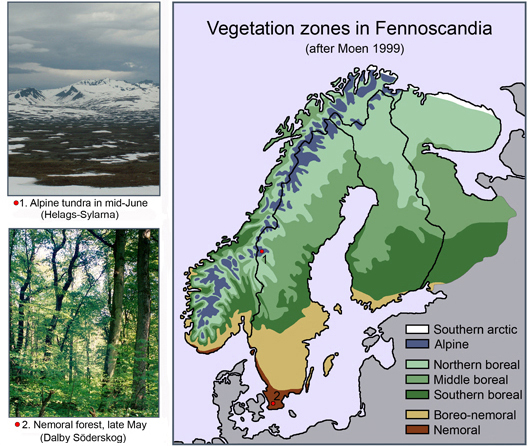 xxxxxxxxxxxxxxxxxxxxxxxxxxx Reference:
Moen A (1999) National Atlas of Norway - Vegetation. xxxxxxxxxxxxxxxxxxxxxxxxxxxxxxxx xxxNorwegian mapping authority. Hønefoss. xxxxxxxxxxxxxxxxxxxxxxxxxxx Reference:
Moen A (1999) National Atlas of Norway - Vegetation. xxxxxxxxxxxxxxxxxxxxxxxxxxxxxxxx xxxNorwegian mapping authority. Hønefoss. |
| |
Vegetation and Climate
Fennoscandia stretches 1800 km from south to north. Hence, it encompasses several vegetation zones with different climate conditions. In the temperate south, there is a nemoral zone with deciduous broadleaf forest and a boreo-nemoral zone with mixed broadleaf and coniferous forests. Further north, the boreal zone marks a shift to a colder, more continental climate and coniferous forests. In the far north and in the Fennoscandian mountain range, there is arctic and alpine tundra.
Hence, northern Fennoscandia has harsh winters with a long-lasting snow-cover and only a short growing season in summer, whilst southern Fennoscandia has little or no snow in winter and a long-lasting growing season.
This difference is illustrated by the photos to the left. In May-June, the nemoral broadleaf forest in southern Fennoscandia stands lush and green, whilst the alpine tundra experiences the last stages of snow-melt. |
|
| |
|
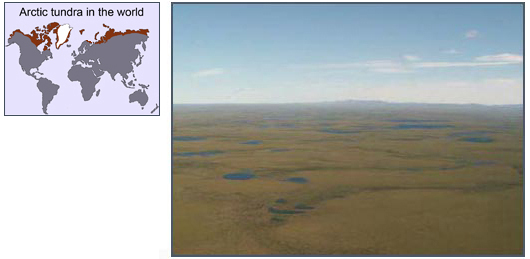 ........................................Arctic tundra in summer
........................................Arctic tundra in summer
...............................................(Chukotka, north-eastern Russia) |
| |
The arctic zone (tundra)
The arctic zone, or arctic tundra, is located north of the climatic forest line. Tundra vegetation is dominated by sedges, dwarfed shrubs, herbs, lichens and mosses. Mammals such as arctic foxes and lemmings spend the whole year on the tundra, whilst reindeer or caribou graze there in summer and migrate to the boreal forest zone in winter.
There is a narrow stretch of "southern arctic tundra" in northernmost Fennoscandia. In southern tundra, there may be occasional trees but no forests.
|
|
| |
|
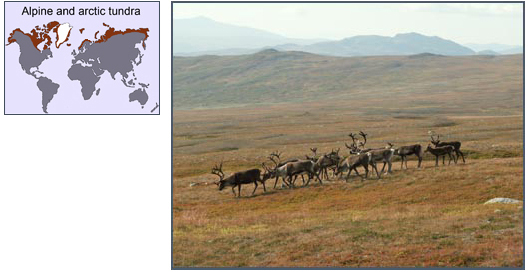 ......................................Alpine tundra with reindeer in late summer ......................................Alpine tundra with reindeer in late summer
.....................................(Marsfjället, north-western Sweden) |
| |
The alpine zone
(mountain tundra)
Whilst the arctic tundra is located north of the forest line, alpine tundra is found on mountains which reach above the forest line. The Fennoscandian mountain range runs south from northern Norway, along the Norwegian-Swedish border to south-western Norway. The alpine zone can be seen as a southern extension of the arctic zone. It has a harsh climate, tundra vegetation and mammals such as arctic foxes, lemmings and reindeer.
All reindeer in Sweden and most reindeer in the other countries are semi-domesticated, own by Sami reindeer herders. |
|
| |
|
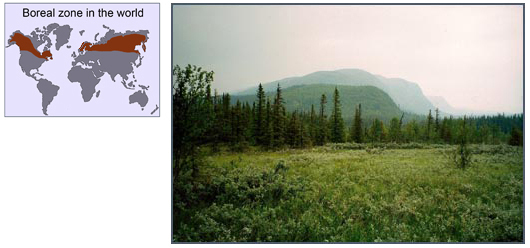
.........................................Northern boreal coniferous forest in summer
.........................................(near Marsliden, north-western Sweden) |
| |
The boreal zone
(coniferous forest)
The boreal forest is dominated by needleleaf trees such as pine and spruce but there are some deciduous trees, in particular birch and aspen. Within the forest, there are bogs with bog-mosses, sedges and shrubs.
The boreal forest is also called taiga.
Photo: Northern boreal spruce and birch forest with a bog in the foreground. The Fennoscandian mountain range can be discerned in the background. |
|
| |
|
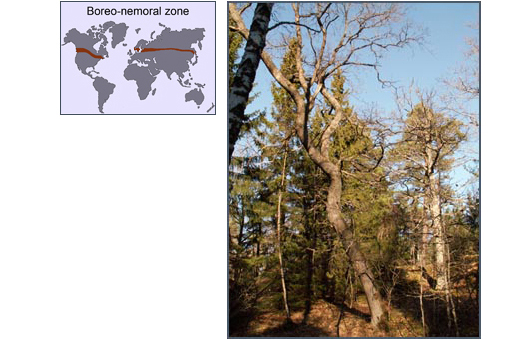
............................................Boreo-nemoral mixed forest in early spring
............................................(Nackareservatet, outside Stockholm, Sweden) |
| |
The boreo-nemoral zone
(mixed forest)
The boreo-nemoral zone is a transitional zone. Depending on the local conditions, boreo-nemoral forests can be dominated by either coniferous or broadleaf trees. Pine, spruce, birch and aspen are common tree species, but there are also hardwood broadleaved species such as oak, elm, ash and maple.
Agriculture is common in boreo-nemoral Fennoscandia. Hence, forests growing on rich soils have often been converted to agricultural lands.
Photo: Mixed forest with oak, birch, pine and spruce in early spring, before the deciduous trees come into leaf. |
|
| |
|
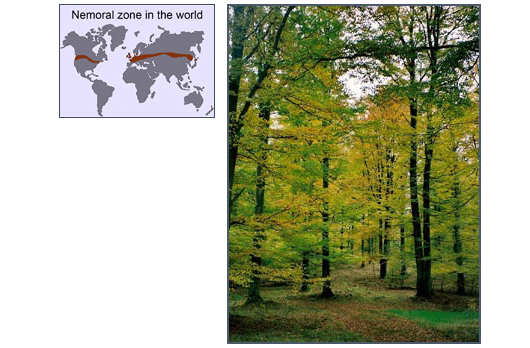
............................................Nemoral broadleaf forest in autumn
............................................(Söderåsen, southern Sweden) |
| |
The nemoral zone
The natural vegetation in the nemoral zone is characterised by deciduous broadleaf forests. In Europe, these forests are dominated by hardwood tree species such as oak, beech and elm.
The nemoral zone is more productive than the other vegetation zones in Fennoscandia. Hence, most natural forests have been cleared to give way for arable agriculture. In fact, nemoral forests are often found in nature reserves or national parks such as Dalby Söderskog and Söderåsen.
Photo: Nemoral beech forest in Söderåsen, southern Sweden.
|
|
| |
|
|
